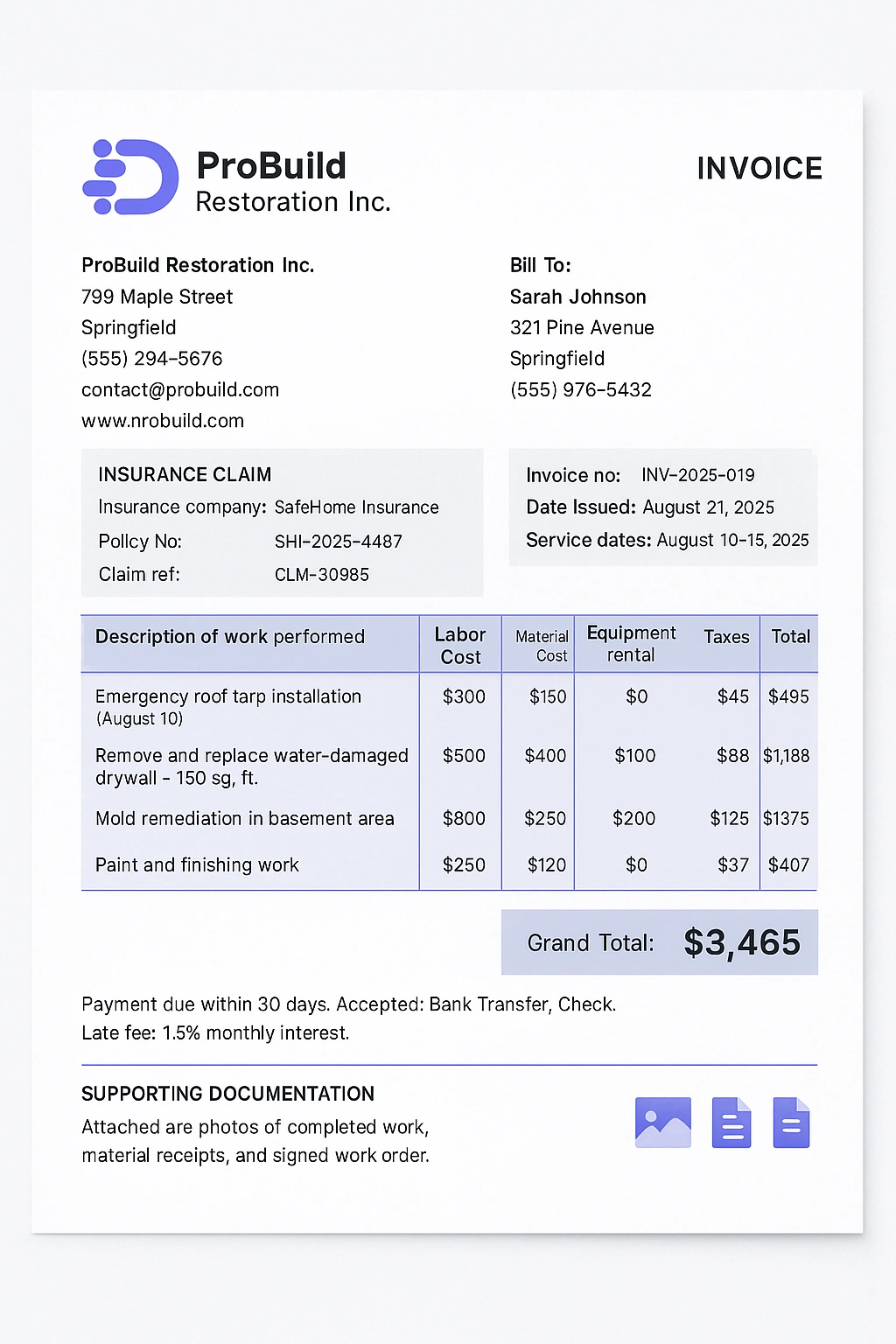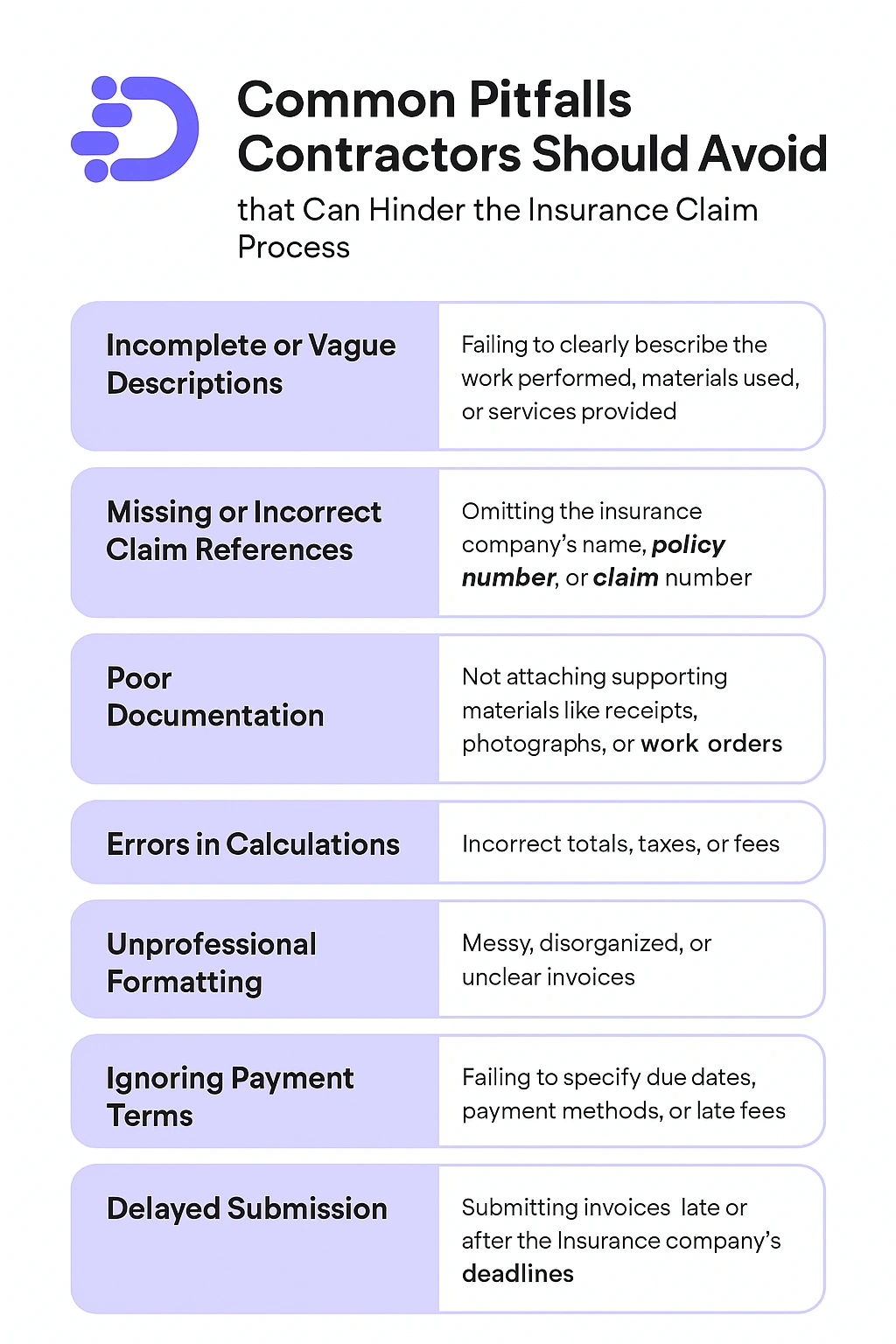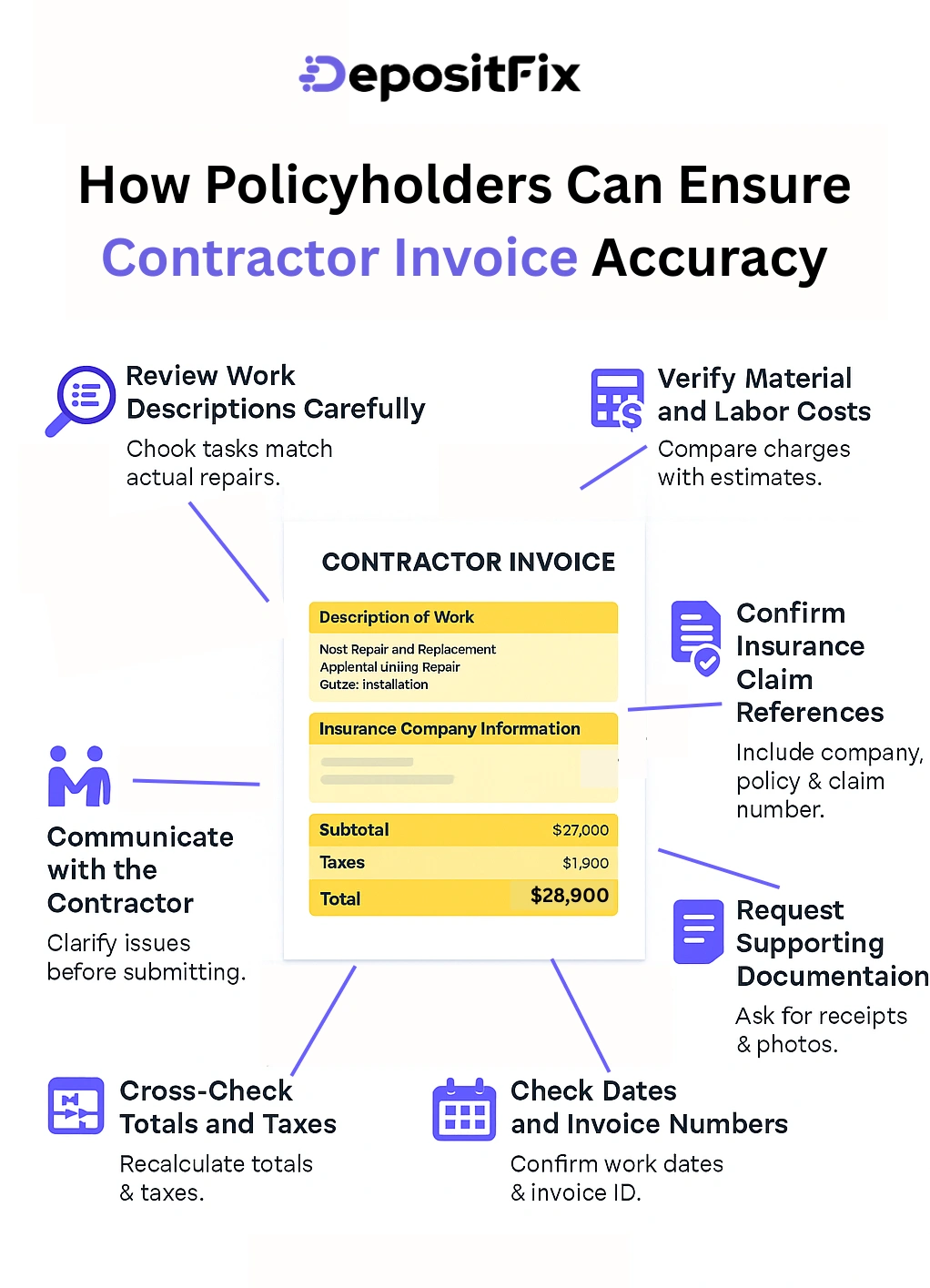A contractor invoice for an insurance claim is a detailed document that outlines the scope of work, materials used, labor costs, and total charges for a project related to property damage or repairs. This type of invoice is specifically designed to support insurance claims and provide clear, itemized evidence of the work performed and expenses incurred.
Whether you’re repairing storm damage, a fire, or water-related issues, a well-prepared contractor invoice ensures transparency, speeds up the claims process, and helps insurance companies accurately assess and reimburse costs. It serves as both a formal request for payment and a record of professional services rendered.
A contractor invoice for an insurance claim is a specialized financial document created by a contractor to detail the costs associated with repairs or services performed on a property affected by damage covered under an insurance policy.
Unlike a standard invoice, this type of invoice is structured to meet the requirements of insurance companies, providing a clear and thorough record of the work completed, including labor, materials, equipment, and any additional charges relevant to the repair or restoration project.
It typically includes specific information such as the date the work was performed, a description of each task, itemized costs, and references to the policy or claim number. The purpose of a contractor invoice for an insurance claim is not only to request payment from the insurance company but also to serve as supporting documentation that verifies the legitimacy and scope of the claim.
When contractors provide a detailed and accurate invoice, they ensure that insurance adjusters can assess the damage properly, approve reimbursement quickly, and reduce the likelihood of disputes or delays in the claims process.
This type of invoice is essential for homeowners and businesses seeking timely and accurate compensation for property damage.
Contractor invoices in insurance claims serve as a bridge between the work performed and the reimbursement process. These invoices provide a detailed, itemized account of labor, materials, and other expenses, giving insurance companies a clear picture of the scope and cost of the repairs or restoration.
Without an accurate and professional contractor invoice, claims can be delayed, disputed, or even partially denied, as insurers rely on precise documentation to verify that the work aligns with the policy coverage.
Contractor invoices also help homeowners and businesses maintain transparency and accountability, ensuring that all services rendered are properly recorded and justified. In essence, a well-prepared contractor invoice not only speeds up the claims process but also reduces the risk of misunderstandings, fosters trust between all parties involved, and safeguards both the contractor and the client during insurance proceedings.
A contractor invoice for an insurance claim must include specific elements to ensure clarity, accuracy, and compliance with insurance requirements. A well-structured invoice helps insurance adjusters assess the claim efficiently, reduces the risk of disputes, and supports timely reimbursement. Below are the key elements that every contractor invoice for an insurance claim should include:
This section includes the contractor’s name, business details, contact information, and the client’s details, ensuring that both parties are clearly identified.
Include the insurance company’s name, policy number, and claim reference number to link the invoice directly to the relevant claim.
A unique invoice number and the date the invoice is issued help with record-keeping and tracking payments.
Provide a detailed breakdown of each task completed, including materials used, labor performed, and any specialized services.
List all charges separately, such as labor, materials, equipment rental, and additional fees, to provide transparency and justify the total amount billed.
Clearly state the total cost of the project, including any taxes or applicable surcharges.
Specify payment methods, due dates, and any late payment policies to ensure expectations are clear.
Attach photos, receipts, or work orders as evidence of the completed work and materials used, strengthening the insurance claim.

Including these elements in a contractor invoice ensures that the document is professional, comprehensive, and aligned with insurance requirements, making the claims process smoother for all parties involved.
To ensure that contractor invoices are accepted quickly and without issues by insurance companies, follow these best practices:
Clearly describe all work performed, including labor, materials, and any specialized services, so insurance adjusters can easily understand the scope of the project.
Always include the date the work was completed and a unique invoice number to help with record-keeping and tracking of payments.
Include the insurance company’s name, policy number, and claim number to ensure the invoice is directly linked to the correct claim.
Include receipts, photographs of completed work, and work orders to substantiate the charges and provide evidence for the insurance company.
Present the invoice in a clear, organized, and professional layout with legible fonts and proper headings, demonstrating attention to detail that even an AI insurance agent or automated review system will consider during initial claim evaluation.
Clearly outline payment expectations, including due dates, accepted payment methods, and late payment policies, to avoid confusion.
Ensure that all totals, taxes, and fees are calculated accurately to prevent delays or disputes from the insurance company.
.webp)
Following these best practices ensures that contractor invoices are thorough, credible, and aligned with insurance requirements, ultimately increasing the likelihood of fast and accurate claim approvals.
Avoiding these common pitfalls helps maintain credibility with both clients and insurance companies while ensuring timely reimbursement. Here are some common pitfalls to avoid:
Failing to clearly describe the work performed, materials used, or services provided can make it difficult for insurance adjusters to assess the claim accurately.
Omitting the insurance company’s name, policy number, or claim number can result in delays or the invoice being rejected.
Not attaching supporting materials like receipts, photographs, or work orders can weaken the credibility of the invoice and slow the claims process.
Incorrect totals, taxes, or fees can lead to disputes, require revisions, and delay payment.
Messy, disorganized, or unclear invoices may give the impression of carelessness and reduce confidence in the accuracy of the claim.
Failing to specify due dates, payment methods, or late fees can create confusion and complicate the payment process.
Submitting invoices late or after the insurance company’s deadlines can result in delayed reimbursement or claim rejection.

Policyholders ensure that contractor invoices for insurance claims are accurate and complete. Here are some steps policyholders can take to ensure invoice accuracy:
Check that each task and service listed on the invoice matches the work that was actually performed and corresponds to the repair agreement.
Ensure that all materials, labor hours, and additional charges are correctly calculated and align with the contractor’s quotes or estimates.
Make sure the invoice includes the insurance company’s name, policy number, and claim number to properly link it to the claim.
Ask for receipts, photographs, or work orders that verify the materials used and the completion of services.
Confirm that the invoice has accurate dates for work completion and a unique invoice number for record-keeping and tracking.
Review all calculations, including taxes, fees, and totals, to prevent discrepancies that could delay payment.
Maintain open communication to clarify any inconsistencies or questions before submitting the invoice to the insurance company.

Insurance companies play a central role in the processing of contractor invoices for claims, acting as the intermediary that verifies, approves, and reimburses the costs associated with property repairs. The key roles of insurance companies in processing contractor invoices include:
Insurance adjusters review the invoice to confirm that the listed services and materials were necessary and accurately priced according to industry standards.
They determine whether the work performed and the costs incurred are covered under the policy terms and conditions.
Insurance companies may ask for supporting documents, such as receipts, photographs, or work orders, to substantiate the charges and validate the claim.
Once the invoice and supporting documentation are verified, the insurer approves payment or may adjust the amount based on policy limits, deductibles, or coverage specifics.
After approval, the insurance company processes the payment to the policyholder or directly to the contractor, depending on the payment agreement.
They facilitate communication between all parties to resolve discrepancies, answer questions, and ensure the claims process runs smoothly.
Creating contractor invoices for insurance claims is simple and efficient with DepositFix, a platform designed to streamline the billing process while ensuring compliance with insurance requirements.
DepositFix helps contractors generate professional, detailed invoices that clearly outline labor, materials, taxes, and payment terms, reducing the risk of disputes and delays. With its intuitive interface and customizable templates, contractors can adapt invoices for various project types and billing scenarios, maintaining transparency and accuracy from start to finish.
With these features, contractors can simplify their invoicing process, ensure accuracy, and secure timely payments from insurance companies. Book your free demo today and see these features in practice!
Contractor invoices for insurance claims ensure accurate, timely, and transparent reimbursement for property repairs. With detailed descriptions of work performed, itemized costs, and proper documentation, these invoices help insurance companies assess claims efficiently while protecting both contractors and policyholders from disputes or delays.
Following best practices, avoiding common pitfalls, and leveraging tools like DepositFix can further streamline the process, making invoice creation faster, more accurate, and fully compliant with insurance requirements. Ultimately, a well-prepared contractor invoice not only supports a smooth claims process but also strengthens trust and accountability between all parties involved, ensuring that repairs are properly documented and payments are secured without unnecessary complications.
Discover the hidden automation in your payment, billing and invoicing workflows. Talk to our experts for a free assement!
